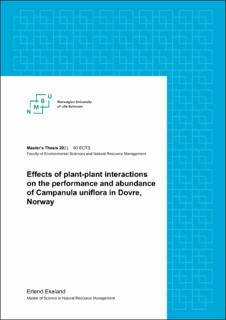| dc.description.abstract | Anthropogenic environmental changes cause direct and indirect negative effects on alpine ecosystems. Human activities are accelerating the greenhouse effect and fragmenting and changing habitats. Increased temperature has made it easier for species from lower elevations to increase their habitat to higher elevations, which results in novel interactions between species.
Plant-plant interactions are a key process driving plant community composition. Species in plant communities can have negative interactions with a neighbor, and positive interactions with another, affecting a third neighbor indirectly. Plants compete for light, space, water, and nutrients. However, we expect facilitation such as enhanced microclimate and improved water and nutrient availability to be more important than competition in alpine plant communities. The aim of this study is to investigate how competition and facilitation affect the performance, abundance and fine spatial-scale distribution of Campanula uniflora L.
In the summer of 2020, I conducted a removal experiment where I compared the performance of individuals growing alone naturally, with individuals growing in intact vegetation, and individuals that had their surrounding vegetation removed. Performance was based on recorded growth variables of 122 individuals of C. uniflora from June to August at the mountains Steinhøi and Råtåsjøhøi in the Dovrefjell region of central Norway. The plants occurred in patches on top of wind exposed ridges in calcareous soils. To relate C. uniflora to the rest of
the vegetation I did a vegetation analysis where I determined the percentage cover of all species present in C. uniflora’s habitat. In addition, during the analysis I recorded what substrate each individual of C. uniflora grew in. A generalized linear model was used to predict biomass accumulation in different treatments.
C. uniflora showed no significant response to removal of neighboring vegetation. Individuals that grew alone naturally had significantly lower biomass than the control and removal group. The vegetation analysis showed that open ground with no vegetation covered 45-60%, lichens 20-40%, mixed plant community 15-25%, Silene acaulis 3.5% and C. uniflora 0.3%.
The proportion of C. uniflora growing within S. acaulis was surprisingly high. Nearly 40% of all C. uniflora individuals grew within S. acaulis cushions. This finding emphasizes the importance of positive interactions in harsh environments and suggests a strong positive relationship between S. acaulis and C. uniflora. | en_US |

